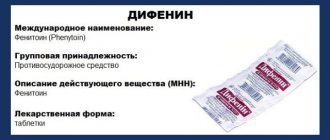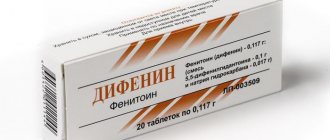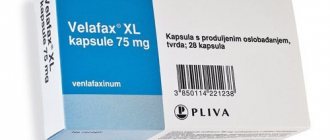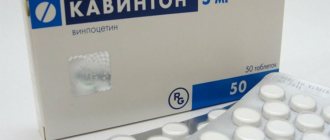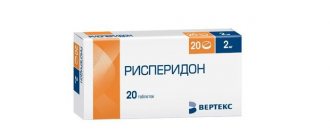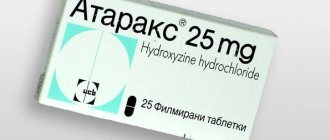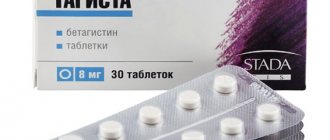Indications for use
- Treatment of epilepsy of various origins;
- Relief of generalized and partial epileptic seizures, as well as the convulsive component in organic diseases of the brain;
- When there are changes in the behavior and character of the patient caused by epilepsy;
- West, Lennox-Gastaut syndrome;
- Childhood tics and febrile convulsions in children;
- In the complex treatment of manic-depressive psychosis occurring with bipolar symptoms and when the prescription of other drugs is ineffective.
High sensitivity to the drug, hepatitis occurring in acute or chronic form, pancreatic diseases, hemorrhagic diathesis, porphyria, first trimester of pregnancy, severe thrombocytopenia, lactation period, age up to 3 years (for tablet form).
Take with caution in case of anemia, leukopenia, thrombocytopenia caused by inhibition of bone marrow hematopoiesis, renal failure, brain diseases with organic lesions, hypoproteinemia, congenital enzymopathy, mental retardation in children. https://www.youtube.com/embed/1wAo3tr_CEc
The drug is used to treat adults and children. It is used as monotherapy and also as an additional agent in combination with other anticonvulsants. Indications for its use are:
- Generalized or idiopathic epilepsy. It is hereditary and, as a rule, appears in childhood. The following forms are treated with the drug:
- tonic;
- tonic-clonic;
- myoclonic;
- minor non-convulsive seizures (absences).
clonic;
In some cases, it is prohibited to take Valparin. Among its contraindications are:
- individual intolerance to the active substance or auxiliary components of the drug;
- severe liver pathologies (acute and chronic forms of hepatitis, liver failure);
- porphyrin disease;
- simultaneous use with mefloquine and drugs based on St. John's wort;
- children under 3 years of age;
- lactation period.
Side effects and contraindications
With caution and under the supervision of a doctor, it is possible to take the medicine for the following conditions:
- hematopoietic disorders (leukopenia, anemia, thrombocytopenia);
- history of pancreatic pathology;
- disruption of enzyme activity;
- kidney and liver diseases;
- organic brain lesions;
- hypoproteinemia;
- mental development disorder in a child.
After numerous animal studies, the negative effects of valproate on the fetus have been proven. This substance provokes a disruption in the development of the neural tube during pregnancy. In this case, the child may develop various defects (shortened limbs, cardiovascular abnormalities).
Most often, such disorders are observed during combination therapy. If you take only Valparin, the risk of such disorders is significantly reduced. Therefore, pregnant women, if necessary, can be prescribed the drug, but the dosage should be reduced to the minimum effective and divided into 2 doses. Additionally, folic acid is prescribed (up to 5 mg per day), which helps prevent malformations of the neural tube of the fetus.
Children under 3 years of age are not allowed to take the medicine. It should also not be prescribed to women who are breastfeeding (the substance passes into breast milk in high concentrations). If a nursing mother needs to take such a remedy, then lactation should be stopped.
- Generalized or idiopathic epilepsy. It is hereditary and, as a rule, appears in childhood. The following forms are treated with the drug:
- tonic;
- tonic-clonic;
- myoclonic;
- minor non-convulsive seizures (absences).
clonic;
Indications and restrictions
The drug is used to treat adults and children. It is used as monotherapy and also as an additional agent in combination with other anticonvulsants. Indications for its use are:
Generalized or idiopathic epilepsy. It is hereditary and, as a rule, appears in childhood. The following forms are treated with the drug:- tonic;
clonic;
- tonic-clonic;
- myoclonic;
- minor non-convulsive seizures (absences).
The drug can also be used for the treatment and prevention of bipolar affective disorders (manic-depressive psychosis). This condition is observed only in adults.
In some cases, it is prohibited to take Valparin. Among its contraindications are:
- individual intolerance to the active substance or auxiliary components of the drug;
- severe liver pathologies (acute and chronic forms of hepatitis, liver failure);
- porphyrin disease;
- simultaneous use with mefloquine and drugs based on St. John's wort;
- children under 3 years of age;
- lactation period.
Side effects and contraindications
With caution and under the supervision of a doctor, it is possible to take the medicine for the following conditions:
- hematopoietic disorders (leukopenia, anemia, thrombocytopenia);
- history of pancreatic pathology;
- disruption of enzyme activity;
- kidney and liver diseases;
- organic brain lesions;
- hypoproteinemia;
- mental development disorder in a child.
After numerous animal studies, the negative effects of valproate on the fetus have been proven. This substance provokes a disruption in the development of the neural tube during pregnancy. In this case, the child may develop various defects (shortened limbs, cardiovascular abnormalities).
Most often, such disorders are observed during combination therapy. If you take only Valparin, the risk of such disorders is significantly reduced. Therefore, pregnant women, if necessary, can be prescribed the drug, but the dosage should be reduced to the minimum effective and divided into 2 doses. Additionally, folic acid is prescribed (up to 5 mg per day), which helps prevent malformations of the neural tube of the fetus.
Children under 3 years of age are not allowed to take the medicine. It should also not be prescribed to women who are breastfeeding (the substance passes into breast milk in high concentrations). If a nursing mother needs to take such a remedy, then lactation should be stopped.
VALPARINE: DOSAGE
The dosage regimen is selected individually depending on the age and body weight of the patient.
The initial daily dose for adults and children weighing more than 25 kg is usually 10-15 mg/kg. Then the dose is gradually increased by 5-10 mg/kg per week until the optimal effect is achieved. The average daily dose of 30 mg/kg body weight can be increased under the control of the drug concentration in the blood plasma to 60 mg/kg.
The dose of the drug is calculated in milligrams (1 ml of the drug contains 40 mg of valproic acid). Take with meals.
It is recommended to divide the daily dose into 2-3 doses.
The solution for oral administration is available in a bottle with a measuring cap. The drug should be used using a measuring cap.
Similar means
Popular analogues of Volparin are drugs based on valproic acid. Among them:
Depakine. An effective anticonvulsant, which is available in various dosage forms (syrup, tablets, powder for the preparation of solution for injection). There is even a type of drug that is gentle on the stomach (Depakine Enteric). Produced pharmaceutically. The cost of Depakine (500 mg) is 680 rubles.
- Convulex. A German medicine that, in addition to its antiepileptic effect, is also effective in preventing migraines. Available in the form of syrup, drops, injections and tablets. The price of the drug is from 340 (300 mg) to 510 (500 mg) rubles.
- Encorat Chrono. An Indian anticonvulsant drug based on valproate, produced only in tablet form. It has a more affordable price - from 180 to 440 rubles.
Only the attending physician can prescribe this or that drug, and he also determines the dosage and duration of the therapeutic course.
Drug interactions
Contraindicated combinations
Mefloquine: risk of epileptic seizures in patients with epilepsy due to increased metabolism of valproic acid and the convulsant effect of mefloquine.
St. John's wort: danger of reducing the concentration of valproic acid in the blood plasma.
Combinations not recommended
Lamotrigine: increased risk of severe skin reactions including toxic epidermal necrolysis. In addition, the plasma concentration of lamotrigine increases (its metabolism in the liver is slowed down by valproic acid). If the combination is necessary, careful clinical and laboratory monitoring is required.
Combinations requiring special precautions
Carbamazepine: increased concentration of the active metabolite of carbamazepine in plasma with signs of overdose. In addition, a decrease in the concentration of valproic acid in plasma is associated with increased metabolism of valproic acid in the liver under the influence of carbamazepine. Recommended: clinical observation, determination of drug concentrations in plasma and, possibly, dose adjustment, especially at the beginning of treatment.
Carbapenems, monobactams: meropenem, panipenem, and, by extrapolation, aztreonam and imipenem: increased risk of seizures due to a decrease in the concentration of valproic acid in the blood plasma. Recommended: clinical observation, determination of drug concentrations in blood plasma; dose adjustment of valproic acid may be required during treatment with an antibacterial agent and after its discontinuation.
Felbamate: increased plasma concentrations of valproic acid with the risk of overdose. Recommended: clinical and laboratory monitoring and possible dose revision of valproic acid during treatment with felbamate and after its discontinuation).
Phenobarbital, primidone: increased plasma concentrations of phenobarbital and primidone with signs of overdose, usually in children. In addition, a decrease in the concentration of valproic acid in plasma associated with increased hepatic metabolism under the influence of phenobarbital or primidone. Recommended: clinical monitoring during the first 15 days of combination treatment with immediate reduction of the dose of phenobarbital or primidone at the first signs of sedation, determination of blood concentrations of both anticonvulsants.
Phenytoin: changes in the concentration of phenytoin in plasma, the risk of a decrease in the concentration of valproic acid associated with increased metabolism of valproic acid in the liver under the influence of phenytoin. Recommended: clinical monitoring with determination of plasma concentrations of both antiepileptic drugs and, if necessary, adjustment of their doses.
Topiramate: Risk of hyperammonemia or encephalopathy. Recommended: clinical and laboratory monitoring during the first month of treatment and in case of symptoms of ammonemia.
Neuroleptics, monoamine oxidase inhibitors (MAO inhibitors), antidepressants, benzodiazepines: Valproic acid potentiates the effect of psychotropic drugs such as neuroleptics, MAO inhibitors, antidepressants, benzodiazepines. Recommended: clinical monitoring and, if necessary, dose adjustment of the drug.
Cimetidine and erythromycin: the concentration of valproic acid in the blood plasma increases.
Zidovudine: Valproic acid may increase plasma concentrations of zidovudine, resulting in increased zidovudine toxicity.
Combinations to Consider
Nimodipine (oral and, by extrapolation, parenteral): increased hypotensive effect of nimodipine due to a decrease in its metabolism under the influence of valproic acid and increased concentration in the blood plasma.
Acetylsalicylic acid: increased effects of valproic acid due to an increase in its concentration in the blood plasma.
When used simultaneously with anticoagulants, vitamin K antagonists require careful monitoring of the prothrombin index.
Other forms of interaction
Valproic acid does not have an enzyme-inducing effect and therefore does not affect the effectiveness of hormonal contraceptives containing combinations of estrogen and progesterone.
Valparine® XR
Contraindicated combinations
Mefloquine:
the risk of epileptic seizures in patients with epilepsy due to increased metabolism of valproic acid and convulsant mefloquine.
St. John's wort:
the danger of reducing the concentration of valproic acid in the blood plasma.
Combinations not recommended
Lamotrigine:
increased risk of severe skin reactions up to the development of toxic epidermal necrolysis. In addition, the plasma concentration of lamotrigine increases (its metabolism in the liver is slowed down by valproic acid). If the combination is necessary, careful clinical and laboratory monitoring is required.
Combinations requiring special precautions
Carbamazepine:
an increase in the concentration of the active metabolite of carbamazepine in plasma with signs of overdose. In addition, a decrease in the concentration of valproic acid in plasma is associated with increased metabolism of valproic acid in the liver under the influence of carbamazepine. Recommended: clinical observation, determination of drug concentrations in plasma and, possibly, dose adjustment, especially at the beginning of treatment.
Carbapenems, monobactams:
meropenem, panipenem, and, by extrapolation, aztreonam and imipenem: an increased risk of seizures due to a decrease in the concentration of valproic acid in the blood plasma. Recommended: clinical observation, determination of drug concentrations in blood plasma; dose adjustment of valproic acid may be required during treatment with an antibacterial agent and after its discontinuation.
Felbamat:
increased concentration of valproic acid in blood plasma with the risk of overdose. Recommended: clinical and laboratory monitoring and possible dose revision of valproic acid during treatment with felbamate and after its discontinuation).
Phenobarbital, primidone
: increased plasma concentrations of phenobarbital and primidone with signs of overdose, usually in children. In addition, a decrease in the concentration of valproic acid in plasma associated with increased hepatic metabolism under the influence of phenobarbital or primidone. Recommended: clinical monitoring during the first 15 days of combination treatment with immediate reduction of the dose of phenobarbital or primidone at the first signs of sedation, determination of blood concentrations of both anticonvulsants.
Phenytoin:
changes in the concentration of phenytoin in plasma, the risk of a decrease in the concentration of valproic acid associated with increased metabolism of valproic acid in the liver under the influence of phenytoin. Recommended: clinical monitoring with determination of plasma concentrations of both antiepileptic drugs and, if necessary, adjustment of their doses.
Topiramate
: risk of developing hyperammonemia or encephalopathy. Recommended: clinical and laboratory monitoring during the first month of treatment and in case of symptoms of ammonemia.
Neuroleptics, monoamine oxidase inhibitors (MAOIs), antidepressants, benzodiazepines
: valproic acid potentiates the effect of psychotropic drugs such as antipsychotics, MAO inhibitors, antidepressants, benzodiazepines. Recommended: clinical monitoring and, if necessary, dose adjustment of the drug.
Cimetidine and erythromycin:
the concentration of valproic acid in the blood plasma increases.
Zidovudine
: Valproic acid may increase plasma concentrations of zidovudine, resulting in increased zidovudine toxicity.
Combinations to Consider
Nimodipine (orally and, by extrapolation, parenterally)
: increased hypotensive effect of nimodipine due to a decrease in its metabolism under the influence of valproic acid and an increase in plasma concentration.
Acetylsalicylic acid
: increased effects of valproic acid due to an increase in its concentration in the blood plasma.
When used simultaneously with anticoagulants, vitamin K antagonists require careful monitoring of the prothrombin index.
Other forms of interaction
Valproic acid does not have an enzyme-inducing effect and therefore does not affect the effectiveness of hormonal contraceptives containing combinations of estrogen and progesterone
.
Side effects, signs of overdose
Take Valparin XP tablets without chewing during or after meals, with water 2-3 times a day. Children are allowed to mix the syrup with any liquid or add it to food. It is necessary to use the drug in the form using a measuring cap.
When using the drug in combination therapy, the daily dosage for adult patients is 10-30 mg/kg, followed by an increase of 5-10 mg/kg weekly.
Children weighing less than 20 kg should not use the tablets. In severe cases, the drug can be administered intravenously in a stream or intravenously in a drip of 400-800 mg at a rate of 25 mg/kg for 24, 36, 48 hours. While taking the drug, drinking drinks that contain ethanol is prohibited. Also, during this period, it is recommended to follow a diet due to the risk of weight gain.
Has restrictions during pregnancy. Prohibited during breastfeeding. Has restrictions for children. Has restrictions for the elderly. Has restrictions for liver problems. Has restrictions for kidney problems.
Today, among anticonvulsants, drugs that contain valproic acid are especially popular. One such medicine is Valparin. This drug can effectively relieve the symptoms of convulsive attacks of any severity. According to the instructions for use, Valparin is prescribed for various types of epilepsy in both adults and children.
According to the instructions, Valparin is used both in adult practice and in pediatrics. The rules of administration and dosage are as follows:
- The tablets should be taken orally, preferably with meals. They are swallowed whole with liquid.
- The prescribed dose is divided into 2 doses. One-time use is possible if epilepsy is controlled.
- For elderly people, the dosage is determined depending on their general condition.
- The dosage regimen depends on the age and weight of the patient:
- for adults and children weighing more than 25 kg, a daily dose of 5 to 15 mg per kg of weight is used, which is increased by 5 or 10 mg/kg after a week;
For children weighing less than 25 kg, 15-45 mg per 1 kg of weight is recommended.
If Valparin is replaced by another antiepileptic drug, it is administered gradually, increasing the dose over two weeks. In this case, the dosage of the previously taken medication is gradually reduced and then discontinued.
The medicine can provoke the development of various negative reactions. Most often, the following side effects occur while taking it:
- violation of the coordination of muscle movement (ataxia);
- reversible dementia;
- liver disorders;
- pancreatitis;
- confusion;
- lethargy;
- convulsions, stupor;
- development of a coma;
- headaches and dizziness;
- Parkinson's disease (reversible);
- trembling of limbs;
- drowsiness, fatigue;
- irritability, aggression, hyperactivity;
- motor abnormalities;
- depressive states, psychosis;
- development of hallucinations;
- digestive problems (nausea, vomiting, diarrhea, increased appetite or, conversely, lack thereof), which occur at the beginning of taking the medicine and disappear over time;
- hematopoietic disorders (anemia, leukopenia, thrombocytopenia);
- bleeding, hematoma, hemorrhage;
- urinary incontinence syndrome;
- nystagmus, flashing of spots before the eyes;
- hearing problems;
- peripheral edema;
- abnormal hair loss;
- the appearance of excess weight;
- menstrual irregularities, enlarged mammary glands in women;
- vasculitis;
- angioedema;
- allergic reactions on the skin (itching, burning, rashes, urticaria, erythema).
Vasculitis
An overdose of such drugs is life-threatening and can result in death. It is often accompanied by:
- decrease in blood pressure;
- depression of the respiratory center;
- decrease in reflex activity;
- constriction of the pupils;
- metabolic acidosis;
- comatose state;
- cerebral edema and increased intracranial pressure.
Instructions for medical use of the drug
Vasculitis
Pharmacodynamics and pharmacokinetics
Pharmacodynamics
A drug with antiepileptic action, has a muscle relaxant and sedative effect. The mechanism of action is to inhibit GABA transferase in the brain under the influence of valproic acid and reduce the reuptake of GABA , which leads to a decrease in the excitability of the motor areas of the brain and a decrease in the manifestation of the convulsive component. The therapeutic effect consists of normalizing the mental status of patients with various types of epilepsy and their mood, and has antiepileptic activity. It does not have a therapeutically significant hypnotic or sedative effect, does not inhibit the function of the respiratory center, does not affect blood pressure , kidney function, heart rate and body temperature.
Pharmacokinetics
The drug is quickly absorbed into the gastrointestinal tract , bioavailability is almost 100%. Communication with blood proteins is at the level of 90-95%. Penetrates through the BBB and into the cerebrospinal fluid. The half-life is 16 hours. It is excreted as a glucuronide mainly in the urine. Does not affect the process of biotransformation of estrogens vitamin K antagonists , progestogens .
Overdose
Symptoms: nausea, vomiting, dizziness, diarrhea, respiratory dysfunction, muscle hypotonia, hyporeflexia, miosis, coma with muscle hypotonia, hyporeflexia, miosis, respiratory depression, metabolic acidosis; Cases of intracranial hypertension associated with cerebral edema have been described.
Treatment: in the hospital - gastric lavage, if no more than 10-12 hours have passed after taking the drug; monitoring the state of the cardiovascular and respiratory systems and maintaining effective diuresis. In very severe cases, dialysis is performed. The prognosis is generally good, but a few cases of death have been described.
Form and composition
What form is inherent in the drug "Valparin"? Tablets – this is the form in which the drug in question can be purchased at the pharmacy. They have a prolonged action, a biconvex round shape, and a white shell.
What does Valparin contain? The instructions state that this product contains valproic acid and sodium valproate. It also includes the following excipients: glycerin, colloidal silicon dioxide, eudragit E-100, hydroxypropyl methylcellulose, polyethylene glycol 1500, ethylcellulose, sodium saccharin, silicon dioxide hydrate, eudragit HE-30D, titanium dioxide and talc.
You can purchase the tablets in question in strips of 10 pieces and in a cardboard box, respectively.
general information
Valparin is an effective antiepileptic drug based on valproic acid. It is produced by a pharmaceutical company.
Drug group, INN, application
The drug belongs to the medicinal group of antiepileptic drugs, which are intended for long-term use in order to eliminate or reduce the frequency of seizures and epileptic attacks.
The international nonproprietary name of the drug determines the name of its active substance. In this case, the INN of Valparin is valproic acid. The medicine is used to relieve seizures and treat epilepsy. It is prescribed to both adults and children.
Release form, cost
The drug is produced in the form of long-acting tablets for internal use, film-coated. They have a round convex shape and are white in color. The package contains 30 or 100 tablets.
The retail price depends on the content of the active component in 1 tablet (300 or 500 mg) and their quantity in the package. Average prices for the drug in different pharmacies in Russian cities are presented in the table.
| Pharmacy, city | Concentration of the active substance Valparin, number of tablets per package | Price in rubles |
| Vitamin, St. Petersburg | 300 mg, No. 30 | 217 |
| Vitamin, St. Petersburg | 300 mg, No. 100 | 739 |
| Europharm LLC, Moscow | 300 mg, No. 100 | 705 |
| Laboratory of beauty and health, Moscow | 500 mg, No. 30 | 387 |
| BALTIKA-MED, St. Petersburg | 500 mg, No. 100 | 1365 |
| BALTIKA-MED, St. Petersburg | 300 mg, No. 100 | 695 |
| Apteka.ru, Volgograd | 300 mg, No. 30 | 221 |
| Apteka.ru, Rostov-on-Don | 300 mg, No. 100 | 681 |
Compound
The drug contains an active ingredient – valproate. It is presented in tablets in the form of sodium salt (sodium valproate) and valproic acid, 300 or 500 mg.
Additionally, the composition includes auxiliary components. Among them:
- silica;
- sodium saccharinate;
- glycerol;
- talc;
- cellulose;
- titanium dioxide;
- macrogol and others.
special instructions
Before starting treatment and during the first 6 months of therapy, periodic monitoring of liver function is necessary, especially in patients at risk.
Among the classical tests, the most important are those reflecting protein synthesis in the liver and especially the prothrombin index. If there is a significant decrease in the concentration of prothrombin, a marked decrease in the content of fibrinogen, blood clotting factors, an increase in the concentration of bilirubin and transaminase activity, treatment with Valparin should be suspended. If the patient is receiving salicylates at the same time, they should also be immediately discontinued, since salicylates and valproic acid have common metabolic pathways.
The risk of side effects from the liver is increased during combination anticonvulsant therapy, as well as in children.
Early diagnosis is based primarily on clinical examination
In particular, two factors that may precede jaundice should be taken into account, especially in patients at risk:
- nonspecific general symptoms,
- usually appearing suddenly
- such as asthenia,
- anorexia,
- extreme fatigue
- drowsiness,
- sometimes accompanied by repeated vomiting and abdominal pain;
- recurrence of epileptic seizures during antiepileptic therapy.
The patient, and if it is a child, then his family, should be warned about the need to immediately notify the doctor about the occurrence of these symptoms. In addition to clinical examination, liver function testing should be performed immediately in such cases.
In rare cases, severe forms of pancreatitis have been reported, sometimes with death. These cases were observed regardless of the patient's age and duration of treatment, although the risk of developing pancreatitis decreased with increasing age of the patients. Insufficiency of liver function in pancreatitis increases the risk of death.
It should be emphasized that during treatment with both Valparin and other antiepileptic drugs, a slight, isolated and temporary increase in the activity of liver transaminases may be observed, especially at the beginning of treatment, in the absence of any clinical symptoms. In this case, it is recommended to conduct a more complete examination (including, in particular, determination of the prothrombin index) in order to revise the dose if necessary and repeat the tests depending on changes in parameters.
Before starting therapy, before surgery, if hematomas or spontaneous bleeding occur, a general blood test (including determination of platelet count, bleeding time and coagulogram parameters) is required.
If symptoms of an “acute” abdomen and gastrointestinal symptoms such as nausea, vomiting and/or anorexia occur during treatment, it is necessary to determine the activity of amylase in the blood to exclude acute pancreatitis. If the activity of pancreatic enzymes is increased, the drug should be discontinued and alternative therapeutic measures taken.
When using Valparin in patients with renal failure, it is recommended to take into account the increased concentration of the free form of valproic acid in the blood plasma and reduce the dose.
If it is necessary to prescribe the drug to patients with systemic lupus erythematosus and other diseases of the immune system, the expected therapeutic effect and the possible risk of therapy should be assessed, since disorders of the immune system have been observed in extremely rare cases when using Valparin.
It is not recommended to prescribe the drug to patients with carbamide cycle enzyme deficiency. In such patients, several cases of hyperammonemia accompanied by stupor and/or coma have been described.
During treatment, drinking drinks containing ethanol is not allowed.
Patients should be warned of the risk of weight gain early in treatment and advised to follow a diet to minimize this effect.
Impact on the ability to drive vehicles and operate machinery
During the treatment period, patients must be careful when driving vehicles and other activities that require high concentration of attention and speed of psychomotor reactions.
Valparine
Contraindicated combinations Mefloquine: risk of epileptic seizures in patients with epilepsy due to increased metabolism of valproic acid and the convulsant effect of mefloquine.
St. John's wort: danger of reducing the concentration of valproic acid in the blood plasma.
Combinations not recommended
Lamotrigine: increased risk of severe skin reactions including toxic epidermal necrolysis. In addition, the plasma concentration of lamotrigine increases (its metabolism in the liver is slowed down by valproic acid). If the combination is necessary, careful clinical and laboratory monitoring is required.
Combinations requiring special precautions
Carbamazepine: increased concentration of the active metabolite of carbamazepine in plasma with signs of overdose. In addition, a decrease in the concentration of valproic acid in plasma is associated with increased metabolism of valproic acid in the liver under the influence of carbamazepine. Recommended: clinical observation, determination of drug concentrations in plasma and, possibly, dose adjustment, especially at the beginning of treatment.
Carbapenems, monobactams: meropenem, panipenem, and, by extrapolation, aztreonam and imipenem: increased risk of seizures due to a decrease in the concentration of valproic acid in the blood plasma. Recommended: clinical observation, determination of drug concentrations in blood plasma; dose adjustment of valproic acid may be required during treatment with an antibacterial agent and after its discontinuation.
Felbamate: increased plasma concentrations of valproic acid with the risk of overdose. Recommended: clinical and laboratory monitoring and possible dose revision of valproic acid during treatment with felbamate and after its discontinuation).
Phenobarbital, primidone: increased plasma concentrations of phenobarbital and primidone with signs of overdose, usually in children. In addition, a decrease in the concentration of valproic acid in plasma associated with increased hepatic metabolism under the influence of phenobarbital or primidone. Recommended: clinical monitoring during the first 15 days of combination treatment with immediate reduction of the dose of phenobarbital or primidone at the first signs of sedation, determination of blood concentrations of both anticonvulsants.
Phenytoin: changes in the concentration of phenytoin in plasma, the risk of a decrease in the concentration of valproic acid associated with increased metabolism of valproic acid in the liver under the influence of phenytoin. Recommended: clinical monitoring with determination of plasma concentrations of both antiepileptic drugs and, if necessary, adjustment of their doses.
Topiramate: Risk of hyperammonemia or encephalopathy. Recommended: clinical and laboratory monitoring during the first month of treatment and in case of symptoms of ammonemia.
Neuroleptics, monoamine oxidase inhibitors (MAO inhibitors), antidepressants, benzodiazepines: Valproic acid potentiates the effect of psychotropic drugs such as neuroleptics, MAO inhibitors, antidepressants, benzodiazepines. Recommended: clinical monitoring and, if necessary, dose adjustment of the drug.
Cimetidine and erythromycin: the concentration of valproic acid in the blood plasma increases.
Zidovudine: Valproic acid may increase plasma concentrations of zidovudine, resulting in increased zidovudine toxicity.
Combinations to Consider
Nimodipine (oral and, by extrapolation, parenteral): increased hypotensive effect of nimodipine due to a decrease in its metabolism under the influence of valproic acid and increased concentration in the blood plasma.
Acetylsalicylic acid: increased effects of valproic acid due to an increase in its concentration in the blood plasma.
When used simultaneously with anticoagulants, vitamin K antagonists require careful monitoring of the prothrombin index.
Other forms of interaction
Valproic acid does not have an enzyme-inducing effect and therefore does not affect the effectiveness of hormonal contraceptives containing combinations of estrogen and progesterone.
Instructions for use
According to the instructions, Valparin is used both in adult practice and in pediatrics. The rules of administration and dosage are as follows:
- The tablets should be taken orally, preferably with meals. They are swallowed whole with liquid.
- The prescribed dose is divided into 2 doses. One-time use is possible if epilepsy is controlled.
- For elderly people, the dosage is determined depending on their general condition.
- The dosage regimen depends on the age and weight of the patient:
- for adults and children weighing more than 25 kg, a daily dose of 5 to 15 mg per kg of weight is used, which is increased by 5 or 10 mg/kg after a week;
For children weighing less than 25 kg, 15-45 mg per 1 kg of weight is recommended.
If Valparin is replaced by another antiepileptic drug, it is administered gradually, increasing the dose over two weeks. In this case, the dosage of the previously taken medication is gradually reduced and then discontinued.
Use for liver dysfunction
Contraindicated: acute hepatitis; chronic hepatitis; history of liver disease.
Before starting treatment and during the first 6 months of therapy, periodic monitoring of liver function is necessary, especially in patients at risk.
Among the classical tests, the most important are those reflecting protein synthesis in the liver and especially the prothrombin index. If there is a significant decrease in the concentration of prothrombin, a marked decrease in the content of fibrinogen, blood clotting factors, an increase in the concentration of bilirubin and transaminase activity, treatment with Valparin should be suspended.
The risk of side effects from the liver is increased during combination anticonvulsant therapy, as well as in children.
Early diagnosis is based primarily on clinical examination
In particular, two factors that may precede jaundice should be taken into account, especially in patients at risk:
- nonspecific general symptoms,
- usually appearing suddenly
- such as asthenia,
- anorexia,
- extreme fatigue
- drowsiness,
- sometimes accompanied by repeated vomiting and abdominal pain;
- recurrence of epileptic seizures during antiepileptic therapy.
The patient, and if it is a child, then his family, should be warned about the need to immediately notify the doctor about the occurrence of these symptoms. In addition to clinical examination, liver function testing should be performed immediately in such cases.
Pregnancy and lactation
Animal studies have shown teratogenic effects.
According to available data, in humans, valproic acid predominantly causes disturbances in the development of the neural tube: myelomeningocele, spina bifida (1-2%). Cases of facial dysmorphia and malformations of the limbs (especially shortened limbs), as well as malformations of the cardiovascular system, have been described.
The risk of developmental defects is higher with combination antiepileptic therapy than with valproic acid monotherapy.
Considering the above, during pregnancy the use of the drug is possible only if the expected benefit to the mother outweighs the potential risk to the fetus. During pregnancy, antiepileptic treatment with valproic acid should not be interrupted if it is effective. In such cases, monotherapy is recommended; The minimum effective daily dose should be divided into two doses.
In addition to antiepileptic therapy, folic acid preparations (at a dose of 5 mg/day) can be added, because they help minimize the risk of neural tube malformations.
Valproic acid can cause hemorrhagic syndrome in newborns, which appears to be associated with hypofibrinogenemia. Cases of afibrinogenemia with fatal outcomes have been reported. This may be due to a decrease in a number of blood clotting factors.
In a newborn, it is necessary to determine the number of platelets, the level of fibrinogen in plasma and blood clotting factors.
Valproic acid is excreted in breast milk in concentrations ranging from 1% to 10%. It is recommended to stop breastfeeding while taking the drug.
Valparin XR tablet p.o.long. 500mg N100 TORRENT
Indications for use Treatment of generalized or partial epilepsy, especially with the following types of seizures: - absence seizures; - myoclonic; - tonic-clonic; - atonic. ;Partial epilepsy: - simple or combined seizures; - secondary generalized seizures. ;Specific syndromes (Vest, Lennox-Gastaut). Use during pregnancy and breastfeeding Prescription of the drug during pregnancy is possible only if the expected benefit to the mother outweighs the potential risk to the fetus. If you take the drug during pregnancy, specialized prenatal monitoring of the fetus is mandatory. ;The use of the drug during breastfeeding is not recommended.
Contraindications:
- severe dysfunction of the pancreas; - acute or chronic hepatitis, cases of active hepatitis in a family history (primarily of drug origin); - porphyria; - thrombocytopenia; - pregnancy; - lactation (breastfeeding); - children under 3 years of age; - hypersensitivity to valproic acid and other components of the drug.
Side effect:
From the digestive system: rarely - nausea, vomiting, diarrhea and/or constipation, hepatitis, pancreatitis. ;Allergic reactions: rarely - skin rash, itching, photosensitivity, erythema multiforme, Stevens-Johnson syndrome. ; From the side of the central nervous system: rarely - ataxia, tremor, impaired consciousness, coma. ; From the reproductive system: rarely - menstrual irregularities, secondary amenorrhea. ; From the hematopoietic system: rarely - anemia, thrombocytopenia, neutropenia, leukopenia, decreased fibrinogen content, inhibition of platelet aggregation. ;Other: 2-12% - hair loss; rarely - weight gain, hyperammonemia, creatininemia.
Compound:
Sodium valproate 333 mg; valproic acid 145 mg; which corresponds to the total content of sodium valproate 500 mg; Excipients: colloidal silicon dioxide, hydroxypropyl methylcellulose, ethylcellulose, silicon dioxide hydrate, sodium saccharin, glycerol, titanium dioxide, eudragit E-100, eudragit NE- 30D, polyethylene glycol 1500, talc.
Interaction with other drugs Sodium valproate enhances the effect of antipsychotic drugs, anticonvulsants and antidepressants. Unlike other anticonvulsants, sodium valproate does not induce liver enzymes and therefore does not reduce the effectiveness of oral contraceptives. ;When used together, sodium valproate and warfarin reduce the percentage of binding to plasma proteins of the latter. ;Sodium valproate alters plasma concentrations of phenytoin and lamotrigine. In combination with anticoagulants and acetylsalicylic acid derivatives, the antiplatelet effect is enhanced. See also characteristics .
